What Does it Take to Be an Air Traffic Controller?
Position Description Control air traffic on and within vicinity of airport and movement of air traffic between altitude sectors and control centers according to established procedures and policies. Authorize, regulate, and control commercial airline flights according to government or company regulations to expedite and ensure flight safety.
Life As an Air Traffic Controller
- Provide flight path changes or directions to emergency landing fields for pilots traveling in bad weather or in emergency situations.
- Conduct pre-flight briefings on weather conditions, suggested routes, altitudes, indications of turbulence, or other flight safety information.
- Direct ground traffic, including taxiing aircraft, maintenance or baggage vehicles, or airport workers.
- Initiate or coordinate searches for missing aircraft.
- Direct pilots to runways when space is available or direct them to maintain a traffic pattern until there is space for them to land.
- Analyze factors such as weather reports, fuel requirements, or maps to determine air routes.
Featured schools near , edit
What an Air Traffic Controller Should Know
When polled, Air Traffic Controllers say the following skills are most frequently used in their jobs:
Active Listening: Giving full attention to what other people are saying, taking time to understand the points being made, asking questions as appropriate, and not interrupting at inappropriate times.
Speaking: Talking to others to convey information effectively.
Judgment and Decision Making: Considering the relative costs and benefits of potential actions to choose the most appropriate one.
Critical Thinking: Using logic and reasoning to identify the strengths and weaknesses of alternative solutions, conclusions or approaches to problems.
Monitoring: Monitoring/Assessing performance of yourself, other individuals, or organizations to make improvements or take corrective action.
Complex Problem Solving: Identifying complex problems and reviewing related information to develop and evaluate options and implement solutions.
Types of Air Traffic Controller
- Radar Air Traffic Controller
- Communications Operator
- Airways Control Specialist
- Air Traffic Supervisor
- Airway Controller
Job Outlook for Air Traffic Controllers
In the United States, there were 24,900 jobs for Air Traffic Controller in 2016. New jobs are being produced at a rate of 3.6% which is below the national average. The Bureau of Labor Statistics predicts 900 new jobs for Air Traffic Controller by 2026. There will be an estimated 2,400 positions for Air Traffic Controller per year.
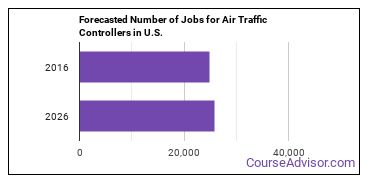
The states with the most job growth for Air Traffic Controller are Nevada, Nebraska, and Louisiana. Watch out if you plan on working in Michigan, Wisconsin, or West Virginia. These states have the worst job growth for this type of profession.
Air Traffic Controller Average Salary
The average yearly salary of an Air Traffic Controller ranges between $68,090 and $178,650.
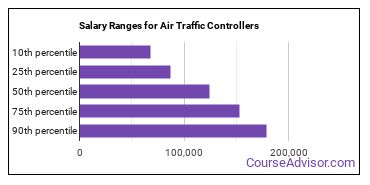
Air Traffic Controllers who work in Illinois, Virginia, or New Hampshire, make the highest salaries.
How much do Air Traffic Controllers make in each U.S. state?
| State | Annual Mean Salary |
|---|---|
| Alabama | $94,370 |
| Alaska | $112,260 |
| Arizona | $110,370 |
| Arkansas | $93,370 |
| California | $132,300 |
| Colorado | $128,210 |
| Connecticut | $88,360 |
| District of Columbia | $75,670 |
| Georgia | $136,210 |
| Hawaii | $110,050 |
| Idaho | $94,910 |
| Illinois | $136,390 |
| Indiana | $122,470 |
| Iowa | $82,460 |
| Kansas | $122,510 |
| Kentucky | $104,890 |
| Louisiana | $86,070 |
| Maryland | $117,610 |
| Massachusetts | $109,430 |
| Michigan | $111,830 |
| Minnesota | $131,330 |
| Mississippi | $84,240 |
| Missouri | $101,280 |
| Montana | $77,150 |
| Nebraska | $92,720 |
| Nevada | $119,600 |
| New Hampshire | $147,350 |
| New Jersey | $118,380 |
| New Mexico | $114,890 |
| New York | $130,840 |
| North Carolina | $109,000 |
| North Dakota | $85,760 |
| Ohio | $131,180 |
| Oklahoma | $109,280 |
| Oregon | $95,570 |
| Pennsylvania | $115,040 |
| South Carolina | $92,070 |
| South Dakota | $82,580 |
| Texas | $133,260 |
| Utah | $118,410 |
| Vermont | $81,630 |
| Virginia | $139,520 |
| West Virginia | $79,710 |
| Wisconsin | $100,500 |
What Tools do Air Traffic Controllers Use?
Although they’re not necessarily needed for all jobs, the following technologies are used by many Air Traffic Controllers:
- Microsoft Excel
- Microsoft Word
- Microsoft Office
- Microsoft PowerPoint
- Microsoft Outlook
- Microsoft Access
- Adobe Acrobat
- Enterprise resource planning ERP software
- SAP software
- Really Simple Syndication RSS
- Flight simulation software
How do I Become an Air Traffic Controller?
What education or degrees do I need to become an Air Traffic Controller?
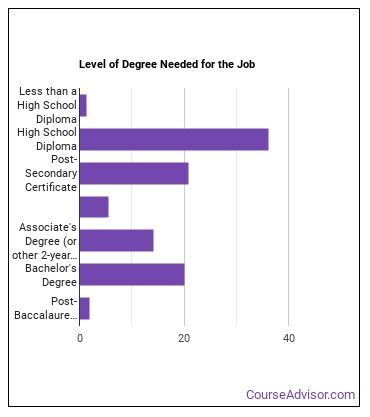
How many years of work experience do I need?
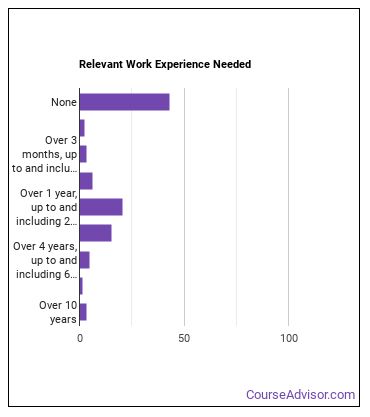
Who Employs Air Traffic Controllers?
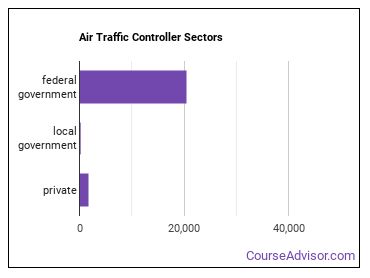
Below are examples of industries where Air Traffic Controllers work:
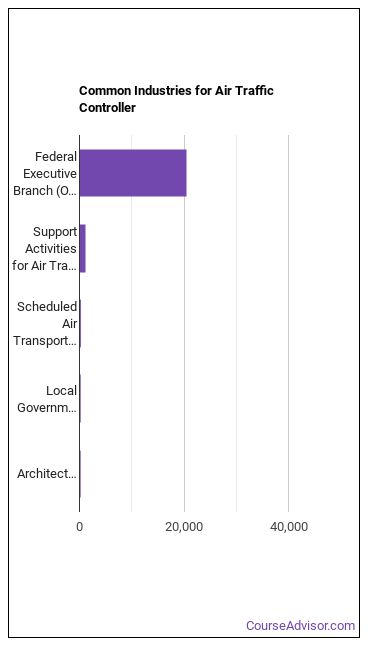
References:
Image Credit: Tech. Sgt. Scott T. Sturkol via U.S. Air Force photo
More about our data sources and methodologies.
Featured Schools
 Request Info
Request Info
|
Southern New Hampshire University You have goals. Southern New Hampshire University can help you get there. Whether you need a bachelor's degree to get into a career or want a master's degree to move up in your current career, SNHU has an online program for you. Find your degree from over 200 online programs. Learn More > |
